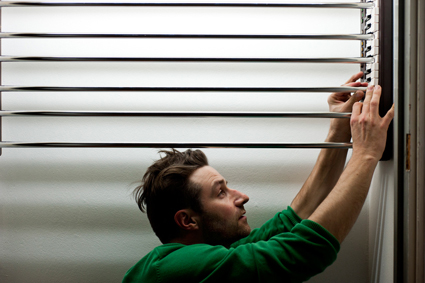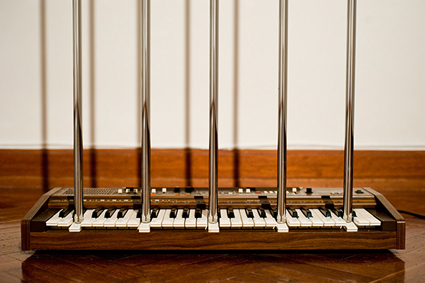 |
Julian Day, Chrissie Cotter Gallery, 2012 photo by Emily Sandrussi |
Day’s installations explore the interaction of architecture and sound using simple and visually striking sculptures. In Lovers, which I recently saw at the Bendigo International Festival of Exploratory Music, four wood-veneer Casio keyboards are pinned to the floor and ceiling with metal poles. The poles hold down keys across the entire range of the keyboards, sending chords of layered sevenths and ninths humming through the space. The gently beating harmonic rainbow shimmers and shifts as you move about the space, a sonic sculpture in itself. It is also a clever sculptural representation of an inversion, with the pole pressing the highest note on one keyboard also pressing the lowest note on its twin. Day finds enduring fascination in this form, which he has developed in over a dozen iterations. As he explained via email, the sculptures produce “a spatial interplay between the static physical objects, their continually expanding drones and the spectator’s compliance within this field. The constantly emanating sound activates the so-called ‘negative space’ of the room, occupying the site with subtle yet persistent energy—what critic and essayist Steven Connor designates “spatiofugal and spatiopetal space.”
Beyond formal experiment, the installations explore a variety of themes and poetic connotations. The history of the materials forms a layer of meaning unto itself. When Day first began using 1970s/80s electronic keyboards in the installations, it was as a statement about cheap consumer electronics and the “fetishization of musical objects,” in particular when there is a steep price tag attached. The original intention was to work with a “museum of unloved objects,” the sort that are usually sold cheaply or given away in garage sales. Now, his vintage Casio keyboards are collectors’ items, implying “an additional museological arc” to the installation.
Other motivations are more personal. Day hears the installation as “a conceptual endgame: twins forced into constant relationship through separation, mute objects brought into life through puncture, sound as a perpetual death cry.” The installations also provide a way of coming to terms with personal failure and “the many seemingly lost years I spent trying to learn the piano, all the while at an insurmountable professional disadvantage of starting at the unbearably late age of 12 and only obtaining a piano at 15 (finally I didn’t have to beg neighbours or recede into music shops on weekends). Here I am finally occupying spaces and situations as if I’d become a professional pianist but with the dumbest means possible.”
 |
Julian Day, twinversion: Lovers (detail), 2012, dimensions variable photo Emily Sandrussi |
Julian Day is still making the invisible visible in his most recent works, including a series of installations at the Stederlijk Museum, Amsterdam. In this series, Day “[brings] hidden phenomena to surface—a slowly descending glissando sine tone suddenly triggering a lone snare drum in the middle of a room, for example, or the strange beating patterns (like an invisible dissonant being) when an instrumental septet play against an undifferentiated held electronic tone.”
RealTime issue #123 Oct-Nov 2014 pg. online
© Matthew Lorenzon; for permission to reproduce apply to [email protected]








 back
back